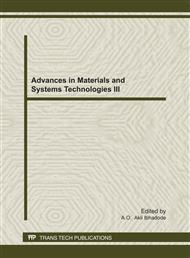p.19
p.27
p.33
p.41
p.49
p.55
p.63
p.75
p.83
An Investigation on the Behaviour of Concrete with Waste Tyre Rubber Fibres as a Partial Replacement of Coarse Aggregate
Abstract:
Concrete is an excellent structural material and considered as essential for the modern civilization and human society. Now, use of waste tyres in concrete has become technically feasible and the concrete is being considered as light weight concrete. The composites were formed with 0%, 5%, 10%, 15%, 20% and 25% of fibers replaced by coarse aggregate weight. The fibers were of different lengths (L) such as 25mm, 50mm and 75mm had holes of diameters (D) 4mm, 5mm and 6mm. The holes functioned as anchors in the cement matrix so that the tyre fibres shall not be separated while placing in the mould. The 3rd, 7th and 28th day’s compression strength and crack patterns were observed on cubes. Split tensile strength on 14th and 28th day were tested on cylindrical specimens. Test results have shown that the increase in rubber content decreases the compressive strength, but, increases the strain energy while conducting the split tensile tests. The composite with fiber specimen L50-D5 and L50-D6 with 10% replacement of coarse aggregate had shown better results than other specimens. However, further studies are needed to reveal the hidden properties of tyre fiber modified concrete.
Info:
Periodical:
Pages:
49-54
Citation:
Online since:
October 2011
Authors:
Keywords:
Price:
Сopyright:
© 2012 Trans Tech Publications Ltd. All Rights Reserved
Share:
Citation:


